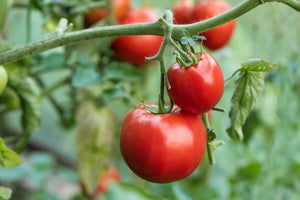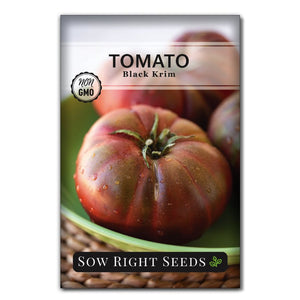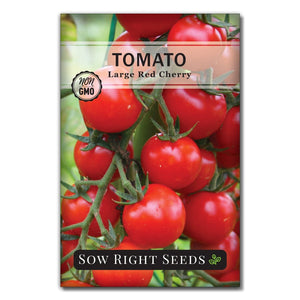What Grows Well With Tomatoes? The A to Z Tomato Companion Plant Guide
TomatoesLots of gardeners start out with tomatoes for good reason. They are easy to grow from seed, and there are many delicious heirloom varieties to try. Once you select your tomatoes, you may look at your garden space and wonder, “What Grows Best With Tomatoes?”
Well, fortunately for you and your garden, there are lots of companion plants for tomatoes.

Companion Plants for Tomatoes
Companion plants can do several things for tomatoes. They can prevent soil nematodes, repel pests, enrich the soil, and encourage beneficial pollinators. And some companion plants make good friends with tomatoes because of their similar growing conditions or ability to share space.
We’ll cover the best companion plants for tomatoes and explain why they make good neighbors. We’ll also cover a few you may want to avoid.
Asparagus
Tomatoes and asparagus might be a surprise combination. But they are true best friends. Asparagus releases a compound that is toxic to root-knot nematodes. And tomatoes produce solanine which repels the asparagus beetle. Asparagus also produces a fungicide that prevents early blight and botrytis in tomato plants. After harvesting early spring asparagus, let the fronds grow and plant your tomatoes.
Basil
The scent of basil repels aphids, whiteflies, mosquitoes, and hornworms. Some gardeners say it makes their tomatoes taste better and increases their harvest. Since basil and tomatoes pair well in recipes, it only makes sense to grow them together.
Our Basil Starter Kit has everything you need to start growing basil.
Bee Balm
Bee Balm is said to improve the growth and flavor of tomatoes. This perennial herb also attracts pollinators.
Learn more about the benefits of Bee Balm.
Black-Eyed Peas
These can be used as a trap crop. Black-eyed peas attract the southern green stink bugs that can spread tomato bacterial wilt. Plant these far enough from your garden to lure the bugs away from tomatoes. Peas also add nitrogen back into the soil and can be rotated with tomatoes.
Borage
Borage is a triple threat. It repels the dreaded tomato hornworms, attracts bees for pollination, and adds trace minerals to the soil. This herb is easy to grow from seed and readily self-sows. It grows in partial shade, so it won’t mind some shade from tall tomato plants.
Calendula
Calendula is another flowering herb that can repel tomato hornworms. It matures quickly and will flower all summer.
Learn more about the benefits of calendula and how to grow it.
Carrots
Carrots are a good neighbor plant and can be grown around tomatoes to aerate the soil. However, while the carrots will improve the tomato yield, snacking pests can decrease the success of growing healthy carrots.
Learn more about growing carrots.
Catnip
Aphids are a common garden problem, and catnip is excellent at deterring them. You may want to contain this plant since it does spread.
Chives
Chives have a beneficial effect on tomatoes. They repel aphids, spider mites, and nematodes. Chives are always blooming, unlike other herbs that stop growing after they flower. So while chives are flowering, they can attract pollinators, repel pests and still be great for eating.
Cilantro/Coriander
Cilantro or coriander attracts parasitic wasps that eat adult hornworms. It also attracts ladybugs that eat aphids. Since it is the flowers that attract these beneficial insects, let your cilantro go to seed.
Learn more about growing cilantro and coriander.
Try our Cilantro Starter Kit for seed starting mix, pots, and everything you need to start growing cilantro.
Lettuce
Lettuce plays well with tomatoes and can be grown nearby. In a fall garden, lettuce can be grown in the partial shade of the tomato plants.
Mint
Aromatic herbs attract beneficial pollinators, and mint is very fragrant. Mint will repel spider mites and aphids.
Plant mint in containers next to your tomatoes so the plant won't spread and take over your whole garden.
Oregano
Grow oregano to attract parasitic wasps, hoverflies, and green lacewings that eat pests. The flowers will also attract pollinators. Its low-growing habitat can also help cool the soil.
Oregano is easy to grow from seed and this perennial herb will come back year after year.
Parsley
Ladybugs are attracted to parsley and ladybugs are beneficial to tomatoes because their larvae can eat large amounts of aphids and hornworm eggs. Parsley also attracts hoverflies and parasitic wasps.
Read more about growing parsley.
Sage
The distinct scent of sage repels slugs, flea beetles, and spider mites.
This easy-to-grow perennial herb can be grown in pots and moved throughout the garden.
Radishes
Radishes can be grown around tomato plants to trap flea beetles. Also, their short roots won’t interfere with the tomato roots.
White Clover
A cover crop of white clover can return nitrogen back to the soil after growing tomatoes.
Learn more about growing White Dutch Clover as a cover crop.
Companion Flowers for Tomato Plants
Growing flowers near your vegetable garden is always recommended. Flowers can repel pests while attracting predatory bugs and beneficial pollinators. These flowers are especially good companions for tomatoes.
Marigolds
This is THE all-purpose vegetable companion plant. Marigolds can do a little bit of everything over an entire season. While they are flowering, they will repel aphids, hornworms, and all kinds of pests. Then, when marigolds are tilled into the soil, they will decompose and release biochemicals that discourage pests like cucumber beetles, root-knot nematodes, squash bugs, and cabbage maggots.
Read everything you need to know to start growing marigolds from seed.
Nasturtiums
These edible flowers will repel aphids, whiteflies, squash bugs, and beetles.
We consider nasturtiums one of the best companion plants for tomatoes and many other vegetables.
Cosmos
Cosmos attract butterflies, lacewings, and hoverflies. You can plant cosmos to flower right along with your tomatoes all summer.
There are several varieties of cosmos, and they are prolific bloomers. They are also one of the easiest flowers to grow from seed.
Zinnias
Zinnias will attract butterflies and bees while they continue blooming all summer. Zinnias make the perfect companion for indeterminate tomatoes that keep growing until the first fall frost.
Learn all about growing zinnias.
Lavender
Known for its fragrance, you can also grow lavender to attract bees and repel flea beetles and nematodes.
Learn the best way to start lavender from seed.
Lavender is a perennial flower in many growing zones.
Sunflowers
Sunflowers can be tall or small. And all colors of sunflowers will attract bees to help pollinate tomatoes.

Companion Planting and Container Gardening
Companion planting also works well in container gardening. Tomatoes grown in containers can be mixed and matched with friendly neighbors. When your tomato plants start putting out flowers, move pots of companions next to them. The additional flowers will attract more pollinators to your tomatoes. Herbs grown in containers are also an excellent way to move companion plants around when needed.
What Not to Plant With Tomatoes
Knowing what not to plant next to your tomato plants can be confusing. Sometimes a NO is because the two plants have different water and soil needs. Other times it’s because they will attract the same pests or be susceptible to the same viruses. So even if a plant isn’t recommended to be grown next to tomatoes, it’s good to know why so you can decide what risks to take.
Plants in the brassica family, such as cabbage, broccoli, and kale, can stunt tomato growth. Also, tomatoes will suck up the nutrients and affect their growth as well.
Don’t plant tomatoes near apricots. Tomatoes can pass diseases to the apricot trees.
Eggplants will draw in the pests that attack tomatoes, so keep them far away.
Fennel stunts the growth of tomatoes.
When dill is young, it’s okay with tomatoes. However, when it starts flowering, it will affect the growth of tomatoes.
Cucumbers and tomatoes aren't great neighbors for several reasons. Tomatoes can spread mosaic virus and bacterial wilt to cucumbers. They are both heavy feeders and need additional fertilizer and could compete for nutrients when close together. Cucumbers prefer moist soil, and tomatoes can dry out between watering.
With careful attention, cucumbers and tomatoes can be grown together, but it might not be the best choice for a beginner gardener.
Corn and tomatoes draw in the same worms. So it’s not recommended to grow them close to each other.
Whether you are a beginner gardener with your first tomato plant or a seasoned veteran, consider companion planting. Choosing the best plants to grow alongside your tomatoes can help deter pests, improve soil quality, and even enhance the flavor of your tomatoes.
Try these tomato companion plants and start experimenting with what works in your garden!
Written by Beverly Laudie








Leave a comment